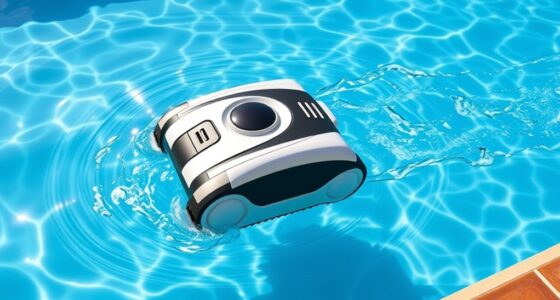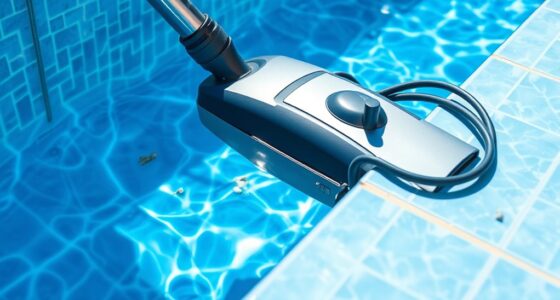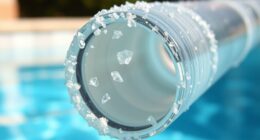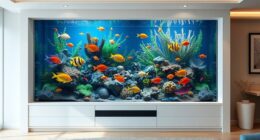To effectively warm up your pool, consider budget-friendly options such as solar heating, heat pumps, pool covers, windbreaks, and high COP heat pumps. These techniques can help optimize energy efficiency while keeping operational expenses in check. Key strategies include controlling peak pool temperatures, strategically reducing heating times, and improving pool efficiency with insulation. By following these energy-saving suggestions and choosing an efficient heating system, you can ensure a pleasant swimming environment without overspending. Remember, every decision you make plays a role in maintaining an enjoyable pool experience while being cost-conscious.
Key Takeaways
- Utilize high COP heat pumps for maximum cost savings and efficiency.
- Opt for solar heating with glazed panels for eco-friendly and cost-effective heating.
- Use pool blankets to reduce heat loss and extend swimming season.
- Implement wind shielding techniques to minimize heat loss and improve energy efficiency.
- Enhance pool efficiency with proper insulation to prevent heat loss and reduce heating costs.
Solar Heating Benefits and Considerations
Solar heating offers a cost-effective and eco-friendly solution for heating your swimming pool by harnessing the sun's energy efficiently. By utilizing solar collectors as part of your pool heating system, you can reduce energy costs in the long run.
While there are initial expenses involved in setting up a solar heating system, the savings and environmental benefits make it a worthwhile investment. However, it's important to take into account your climate and the availability of sunlight when opting for solar heating, as its efficiency relies on ample sunlight.
Glazed panels are recommended for areas with varying weather conditions or for year-round pool usage, providing better heat retention compared to unglazed collectors.
Understanding these aspects will help you maximize the benefits of solar heating for your swimming pool, making it a sustainable and efficient choice for keeping your pool warm while minimizing operating costs.
Utilizing Heat Pumps Effectively

To effectively utilize heat pumps for your swimming pool, make sure to run them during the warmest parts of the day to maximize their efficiency in heating the water.
Choosing a heat pump with a higher COP will save you energy costs over time, making it a cost-effective option for pool heating.
Remember to properly size the heat pump according to your pool's needs for best performance and efficiency.
Heat Pump Benefits
When considering heating options for your swimming pool, utilizing heat pumps effectively can offer significant advantages in terms of energy efficiency and cost savings. Heat pump pool heaters are known for being energy efficient, drawing heat from the air to raise the water temperature with minimal energy consumption.
Operating between -10°C to 45°C, these heaters are versatile and suitable for various climates. Despite their low cost, heat pumps deliver impressive heating performance, typically increasing the water temperature by 3-5 degrees. In fact, some heat pumps can operate for as little as $1 per day, making them a cost-effective solution for keeping your pool comfortably warm.
Maximizing Heat Efficiency
When aiming to maximize heat efficiency in heating your swimming pool, utilizing heat pumps effectively is key to ensuring peak performance and cost-effectiveness.
Heat pumps work by drawing heat from the air to efficiently warm your pool water. To maximize efficiency, operate your heat pumps during the warmest part of the day.
Look for higher Coefficient of Performance (COP) ratings when selecting a heat pump, as these indicate better cost-effectiveness. Properly sizing your heat pumps based on your pool size is essential to achieving ideal heating performance.
Importance of Pool Blankets

Pool blankets are essential for reducing heat loss by preventing evaporation, saving you energy and money in the long run.
With different types available, such as safety covers and heat retention covers, you can choose the one that best suits your needs and budget.
Making the appropriate choice can greatly impact the warmth of your pool water and extend your swimming season.
Blanket Benefits
Using pool blankets can greatly reduce heat loss and save on heating costs for your swimming pool. Here are some benefits of using pool blankets:
- Preventing Heat Loss: Pool blankets act as a barrier, notably reducing evaporative loss and helping maintain the pool temperature. This means you'll spend less on heating your pool to keep it warm.
- Water Conservation: By minimizing evaporation, pool blankets not only save you money on heating costs but also conserve water. This is especially important during hot summer months when evaporation rates are higher.
- Convenience with Automatic Deployment: Opting for pool blankets with automatic deployment options adds convenience to your pool maintenance routine. With just a push of a button, you can cover your pool easily when not in use, maximizing heat retention and energy savings.
Incorporating pool blankets into your pool maintenance routine can make a significant impact on both your heating costs and water conservation efforts, all while ensuring your pool stays at an enjoyable temperature.
Energy Savings
To maximize energy savings and reduce heating costs effectively, incorporating pool blankets into your maintenance routine is a practical and efficient solution.
Pool blankets play an important role in reducing heat loss through evaporation by up to 90%. This significant reduction in evaporation leads to substantial savings of up to 50-70% on heating costs, making pool blankets a cost-effective investment in efficient heating.
Not only do pool blankets help in energy savings, but they also contribute to maintaining a consistent water temperature, ensuring that your pool remains comfortable for swimming.
The convenience of automatic deployment options further enhances the usability of pool blankets, making it easy to cover and uncover your pool as needed.
Bubble or floating pool blankets, in particular, are affordable and efficient in preventing heat loss and reducing evaporation, making them a practical choice for pool owners looking to optimize energy efficiency and minimize heating expenses.
Wind Shielding Techniques

Implementing effective wind shielding techniques is essential for reducing heat loss and enhancing energy efficiency in swimming pools. Wind can accelerate heat loss from your pool, leading to increased energy consumption and higher heating costs.
Here are three key wind shielding techniques to help you maximize energy savings and maintain ideal water temperature:
- Install Windbreaks: Setting up windbreaks like fences or vegetation around your pool can greatly reduce heat loss by creating a barrier against the wind. This simple step helps retain heat in the pool water, lowering energy consumption and heating costs.
- Shielding from Wind: Shielding your pool from direct wind exposure helps maintain a consistent water temperature. By minimizing heat loss due to wind, you can improve the overall efficiency of your pool heating system.
- Maximize Energy Savings: Creating a wind-free environment around your pool not only saves you money on heating costs but also enhances the efficiency of your pool system.
Selecting High COP Heat Pumps
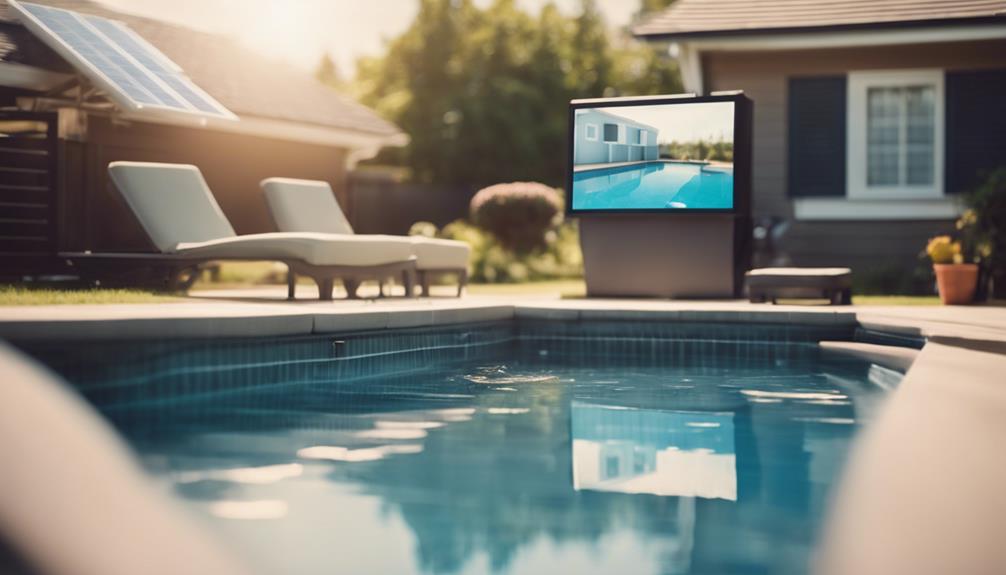
When looking to enhance energy efficiency in heating your swimming pool, consider selecting high COP heat pumps for maximum cost savings and performance.
High COP heat pumps are known for being energy efficient, with COP ratings typically falling between 3.0 to 7.0. The higher the COP, the more heat energy the pump provides per unit of electricity consumed, resulting in significant cost savings over time.
It's important to choose a heat pump with the highest COP rating that fits within your budget to guarantee maximum efficiency. Efficient sizing of the heat pump is also important for top-notch performance and energy savings when heating your pool.
High COP heat pumps not only offer long-term cost savings but also provide eco-friendly benefits compared to traditional heating methods. By selecting a high COP heat pump and ensuring it's properly sized for your pool, you can achieve both financial savings and environmental sustainability in your pool heating system.
Optimal Pool Temperature Control
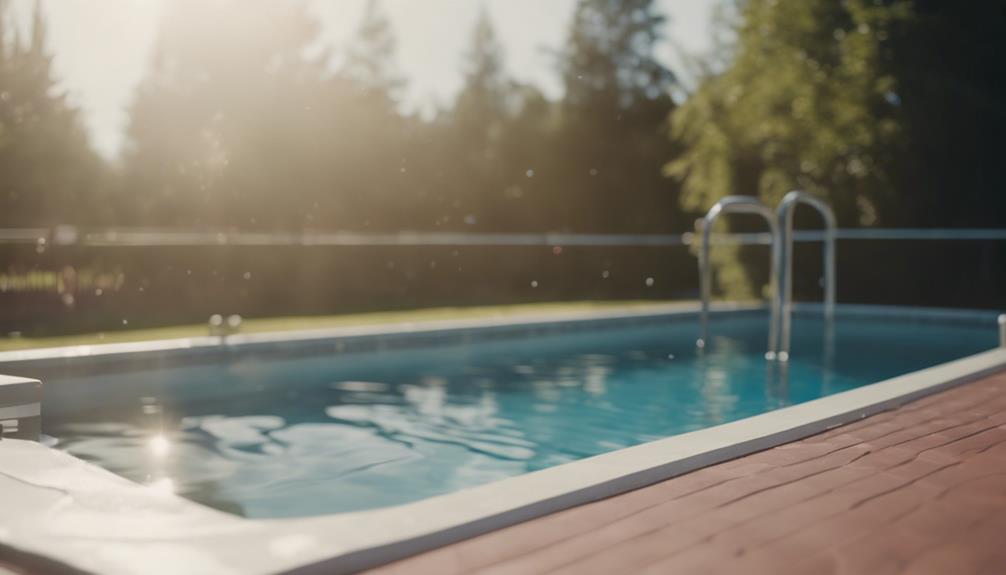
Efficient pool temperature control is essential for balancing comfort and cost savings. To achieve ideal pool temperature control, consider the following:
- Maintain a Cost-Effective and Comfortable Temperature: Keeping your pool temperature in the low to mid 70s isn't only comfortable but also helps control heating costs. Each degree rise in temperature can have a notable impact on your energy expenses, so finding the right balance is key.
- Utilize Automated Controls: Investing in automated controls can help regulate your pool temperature efficiently. These systems can adjust the heating based on your preferences, ensuring that your pool stays at the desired temperature without unnecessary energy waste.
- Implement Energy Conservation Practices: Turning up the heat only when needed, such as before pool use, and using a pool blanket to retain warmth between swims can aid in energy conservation. By adopting these practices, you can enjoy a comfortable pool temperature while optimizing your heating efficiency.
Reducing Heating Duration Strategically

Strategically reducing the duration of pool heating can lead to significant energy savings and improved operational efficiency. To achieve this, consider factors like ideal heat pump operation and proper sizing.
Running the heat pump during the warmest parts of the day can shorten heating times, making the process more efficient. It's important to confirm that your heat pump is appropriately sized for your pool to avoid energy wastage.
Location-specific elements, such as sun exposure and wind shielding, play an essential role in determining how long your pool needs to be heated. Using pool blankets and wind barriers can help retain heat and reduce the overall heating duration.
Additionally, strategically controlling the temperature settings of your pool can further minimize heating costs. By taking these steps and considering the unique aspects of your pool's location, you can effectively reduce heating duration and optimize the cost-effectiveness of your pool heating system.
Enhancing Pool Efficiency With Insulation
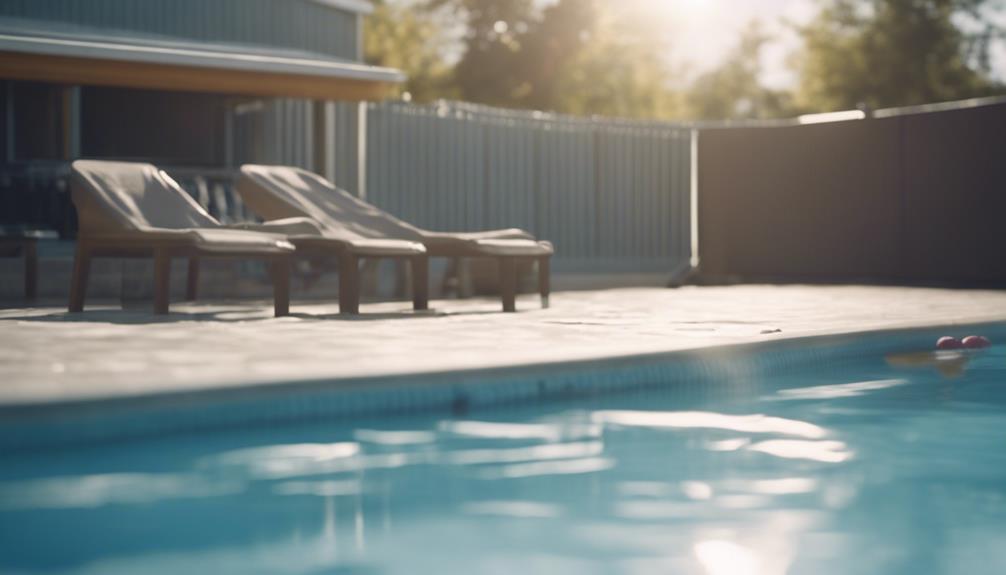
Enhance your pool's efficiency by incorporating effective insulation methods to minimize heat loss and reduce heating costs.
- Pool Insulation:
By insulating your pool, you create a protective barrier that prevents heat loss to the surrounding environment. This helps in maintaining the water temperature and reduces the need for constant heating, ultimately improving energy efficiency.
- Insulation Materials:
Utilize insulation materials like foam boards or thermal blankets to effectively retain heat within the pool. These materials are designed to keep the warmth in, ensuring that your pool stays comfortably heated without excessive energy consumption.
- Investment for Long-Term Savings:
While upgrading your pool's insulation may require an initial investment, the long-term savings on heating expenses make it a worthwhile endeavor. The reduced need for continuous heating translates to lower heating costs over time, making it a smart financial decision for pool owners looking to improve energy efficiency and cut down on expenses.
Energy-Saving Tips for Pool Design

Consider implementing energy-saving tips in your pool design to enhance efficiency and reduce operational costs. To start, strategically place your pool and consider wind shielding to minimize heat loss and increase overall efficiency.
Utilizing pool covers and anti-evaporation devices can greatly reduce heat loss through evaporation, helping maintain a consistent temperature. Optimize your pool's mechanical systems and insulation to enhance heat retention and improve energy efficiency.
When selecting a heating system, prioritize energy-efficient options with a high Coefficient of Performance (COP) rating that aligns with your pool size. Incorporating smart heating controls can further boost efficiency by allowing you to regulate temperature settings effectively.
Remember to schedule regular pool maintenance to guarantee all systems are operating at their peak efficiency levels. By implementing these energy-saving tips in your pool design, you can create a more sustainable and cost-effective swimming experience.
Frequently Asked Questions
What Is the Cheapest Way to Run a Swimming Pool?
To run a swimming pool cost-effectively, consider solar heating. Solar panels power heaters and pumps, cutting energy costs. Upfront expenses are offset by long-term savings. Be mindful of sun exposure for best efficiency.
What Type of Pool Heater Are Most Energy-Efficient?
For the most energy-efficient pool heating, opt for electric heat pumps. These draw heat from the air, costing as low as $1 per day to run. They offer comfort at minimal cost, with high efficiency.
What Is the Cheapest Pool Heater to Run?
To run, the cheapest pool heater is solar heating, harnessing the sun's energy. Electric heat pumps are also cost-effective, heating for as low as $1 per day. Gas heaters are outdated and inefficient, not recommended.
What Is the Black Hose Trick for Heating a Pool?
To heat a pool using the black hose trick, coil a dark garden hose in the sun. The hose absorbs heat, warming the water as it flows through. While cost-effective for small pools, its efficiency varies based on sunlight and conditions.
Are Energy Savers the Most Cost-Effective Way to Heat a Swimming Pool Compared to Efficient Heating Methods?
When it comes to heating a swimming pool, costefficient swimming pool heating methods such as energy savers can be a great option. While efficient heating methods may have higher upfront costs, energy savers can provide long-term savings on energy bills, making them a cost-effective choice for pool owners.
Conclusion
To sum up, when it comes to heating your swimming pool efficiently, there are plenty of cost-effective options to choose from. By utilizing solar heating, heat pumps, pool blankets, wind shielding techniques, and high COP heat pumps, you can keep your pool warm without breaking the bank.
Don't forget to control the temperature, reduce heating duration, insulate effectively, and design your pool for energy savings. With these strategies in place, you'll be swimming in comfort and savings all year round.




